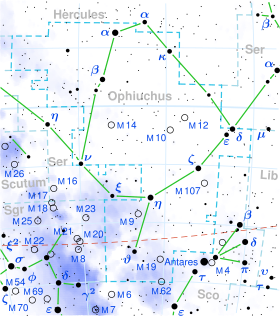72 Ophiuchi
| Observation data Epoch J2000 Equinox J2000 | |
|---|---|
| Constellation | Ophiuchus |
| Right ascension | 18h 07m 20.98393s[1] |
| Declination | 9° 33′ 49.8501″[1] |
| Apparent magnitude (V) | 3.73[2] + 14.0[3] |
| Characteristics | |
| Spectral type | A5 V[4] |
| U−B color index | +0.10[2] |
| B−V color index | +0.12[2] |
| Astrometry | |
| Radial velocity (Rv) | -23.90[5] km/s |
| Proper motion (μ) | RA: -62.17[1] mas/yr Dec.: +79.66[1] mas/yr |
| Parallax (π) | 37.55 ± 0.21 mas[1] |
| Distance | 86.9 ± 0.5 ly (26.6 ± 0.1 pc) |
| Absolute magnitude (MV) | 1.58[6] |
| Details | |
| Mass | 1.99[7] M☉ |
| Radius | 1.9[8] R☉ |
| Luminosity | 20[7] L☉ |
| Surface gravity (log g) | 4.04[9] cgs |
| Temperature | 8,718[9] K |
| Metallicity [Fe/H] | +0.09[6] dex |
| Rotational velocity (v sin i) | 65[7] km/s |
| Age | 250[9] Myr |
| Other designations | |
| Database references | |
| SIMBAD | data |
72 Ophiuchi is a binary star[3] system in the equatorial constellation of Ophiuchus. It is visible to the naked eye as a faint, white-hued point of light with a combined apparent visual magnitude of 3.73.[2] It is located approximately 86.9 light years away from the Sun based on parallax,[1] but is moving closer with a heliocentric radial velocity of -23.9 km/s.[5]
As of 2008, the pair had an angular separation of 25″.[3] According to Gray et al. (2003), the primary component has a stellar classification of A5 V,[4] matching an A-type main-sequence star. Cowley et al. (1969) had assigned it to a class of A4 IVs,[11] suggesting it is a sharp-lined (s) subgiant star. The latter class is still in use by some sources.[7][3][12]
The primary is 250[9] million years old with double[7] the mass of the Sun and is spinning with a moderate projected rotational velocity of 65 km/s.[7] It is radiating 20[7] times the luminosity of the Sun from its photosphere at an effective temperature of 8,718 K.[9] It displays an infrared excess, suggesting a debris disk is orbiting the star with a mean separation of 82.96 AU and temperature of 60 K.[13] The system is a source of X-ray emission,[12] which is most likely coming from the 14th[3] magnitude companion.[12]
There are additional visual companions: component C with magnitude 11.5 lies at an angular separation of 64″ from the primary,[14] while component D, has magnitude 14.8 and separation 24".[15]
References
- ^ a b c d e f Van Leeuwen, F. (2007). "Validation of the new Hipparcos reduction". Astronomy and Astrophysics. 474 (2): 653–664. arXiv:0708.1752. Bibcode:2007A&A...474..653V. doi:10.1051/0004-6361:20078357. S2CID 18759600. Vizier catalog entry
- ^ a b c d Ducati, J. R. (2002). "VizieR Online Data Catalog: Catalogue of Stellar Photometry in Johnson's 11-color system". CDS/ADC Collection of Electronic Catalogues. 2237. Bibcode:2002yCat.2237....0D.
- ^ a b c d e Eggleton, P. P.; Tokovinin, A. A. (September 2008). "A catalogue of multiplicity among bright stellar systems". Monthly Notices of the Royal Astronomical Society. 389 (2): 869–879. arXiv:0806.2878. Bibcode:2008MNRAS.389..869E. doi:10.1111/j.1365-2966.2008.13596.x. S2CID 14878976.
{{cite journal}}: CS1 maint: unflagged free DOI (link) - ^ a b Gray, R. O.; et al. (2003). "Contributions to the Nearby Stars (NStars) Project: Spectroscopy of Stars Earlier than M0 within 40 Parsecs: The Northern Sample. I". The Astronomical Journal. 126 (4): 2048. arXiv:astro-ph/0308182. Bibcode:2003AJ....126.2048G. doi:10.1086/378365. S2CID 119417105.
- ^ a b Kharchenko, N. V.; Scholz, R.-D.; Piskunov, A. E.; Röser, S.; Schilbach, E. (2007). "Astrophysical supplements to the ASCC-2.5: Ia. Radial velocities of ∼55000 stars and mean radial velocities of 516 Galactic open clusters and associations". Astronomische Nachrichten. 328 (9): 889. arXiv:0705.0878. Bibcode:2007AN....328..889K. doi:10.1002/asna.200710776. S2CID 119323941.
- ^ a b Anderson, E.; Francis, Ch. (2012). "XHIP: An extended hipparcos compilation". Astronomy Letters. 38 (5): 331. arXiv:1108.4971. Bibcode:2012AstL...38..331A. doi:10.1134/S1063773712050015. S2CID 119257644. Vizier catalog entry
- ^ a b c d e f g Zorec, J.; Royer, F. (2012). "Rotational velocities of A-type stars". Astronomy & Astrophysics. 537: A120. arXiv:1201.2052. Bibcode:2012A&A...537A.120Z. doi:10.1051/0004-6361/201117691. S2CID 55586789. Vizier catalog entry
- ^ Allende Prieto, C.; Lambert, D. L. (1999). "Fundamental parameters of nearby stars from the comparison with evolutionary calculations: Masses, radii and effective temperatures". Astronomy and Astrophysics. 352: 555–562. arXiv:astro-ph/9911002. Bibcode:1999A&A...352..555A. Vizier catalog entry
- ^ a b c d e David, Trevor J.; Hillenbrand, Lynne A. (2015). "The Ages of Early-Type Stars: Strömgren Photometric Methods Calibrated, Validated, Tested, and Applied to Hosts and Prospective Hosts of Directly Imaged Exoplanets". The Astrophysical Journal. 804 (2): 146. arXiv:1501.03154. Bibcode:2015ApJ...804..146D. doi:10.1088/0004-637X/804/2/146. S2CID 33401607. Vizier catalog entry
- ^ "72 Oph". SIMBAD. Centre de données astronomiques de Strasbourg. Retrieved 2019-06-26.
- ^ Cowley, A.; et al. (April 1969). "A study of the bright A stars. I. A catalogue of spectral classifications". Astronomical Journal. 74: 375–406. Bibcode:1969AJ.....74..375C. doi:10.1086/110819.
- ^ a b c De Rosa, R. J.; et al. (July 2011). "The Volume-limited A-Star (VAST) survey - I. Companions and the unexpected X-ray detection of B6-A7 stars". Monthly Notices of the Royal Astronomical Society. 415 (1): 854–866. arXiv:1103.4363. Bibcode:2011MNRAS.415..854D. doi:10.1111/j.1365-2966.2011.18765.x. S2CID 84181878.
{{cite journal}}: CS1 maint: unflagged free DOI (link) - ^ Gáspár, András; et al. (2016). "The Correlation between Metallicity and Debris Disk Mass". The Astrophysical Journal. 826 (2): 171. arXiv:1604.07403. Bibcode:2016ApJ...826..171G. doi:10.3847/0004-637X/826/2/171. S2CID 119241004.
{{cite journal}}: CS1 maint: unflagged free DOI (link) - ^ Renson, P.; Manfroid, J. (2009). "Catalogue of Ap, HgMn and Am stars". Astronomy and Astrophysics. 498 (3): 961. Bibcode:2009A&A...498..961R. doi:10.1051/0004-6361/200810788.
- ^ Mason, Brian D.; et al. (2001). "The 2001 US Naval Observatory Double Star CD-ROM. I. The Washington Double Star Catalog". The Astronomical Journal. 122 (6): 3466. Bibcode:2001AJ....122.3466M. doi:10.1086/323920. Vizier catalog entry

